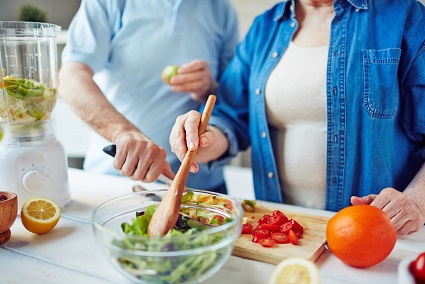Food Safety: 10 Guidelines for the Elderly
Food Safety: It’s that time of year again, when picnics and family gatherings are most popular.
We all know the drill: make food at home, and family and friends will take home the leftovers
By Christine Salazar, RD,
https://www.caring.com/articles/elderly-food-safety-10-tips-guidelines-for-the-elderly
What you might be surprised to learn, however, is that some of the symptoms typically associated with the flu are the same symptoms seen in foodborne illnesses.
As we get older, our immune systems weaken, making it harder to fight off bacteria and serious illness.
Stomach acids decrease, which inhibits the control of bacteria, and kidneys, which help filter bacteria from the blood, weaken.
The problem is, once a foodborne illness is contracted, the ensuing infections can be difficult to treat and can reoccur.
Many foodborne illnesses have symptoms similar to those of a virus, which may include nausea, vomiting, and diarrhea.
These symptoms can lead to dehydration if not properly handled. So what can you do? Following are ten basic guidelines to preventing foodborne illnesses.
1. Have a Thermometer Handy
Food temperature is the first guideline in food safety. Make sure you have a good food thermometer. 40–140° Fahrenheit is considered the danger zone for foodborne illness—bacteria thrive in this zone.
2. Raise the Temperature
Leftovers should be re-heated to 165° Fahrenheit. This includes all meat (including deli meats), seafood, and foods made with eggs.
3. Be Wary of Best Foods
Foods with mayonnaise should not be left out for more then 2 hours. If you are outside and it is over 90° Fahrenheit, don’t leave food out for more than 1 hour.
4. Turn Up the Heat
Cook food to proper temperatures. Cook poultry to 180° (ground poultry to 165°), and beef, veal, pork, lamb, egg dishes and casseroles to 160° Fahrenheit.
Do not re-use meat marinades unless you boil them, which is equal to 165° Fahrenheit. Fish should flake with a fork and shell fish should be opaque throughout.
Eggs should not be firm, not runny.
5. Cool it Off Properly
Store food at the proper temperature. It is important to set your refrigerator below 40° Fahrenheit.
If you are not sure of the temperature it’s at now, purchase a thermometer. Perishable foods must be refrigerated.
6. Wash Up
Well all know we’re supposed to wash our hands before, during and after meal preparation.
But did you know that washing with warm soapy water for at least 20 seconds may eliminate nearly half of all foodborne illness cases ?
As an added bonus, it can also reduce the spread of the flu and the common cold. Keep surfaces clean too, including sinks, shelves, counter tops, refrigerators and freezers.
7. Keep it Clean
It is very important to prevent cross-contamination by keeping raw meats separate from the ready-to-eat foods.
Cutting boards that are cracked or scarred should be discarded.
Use separate cutting boards for raw meats, vegetables and breads.
Wash cutting boards with a sanitizing solution, or mix 1 Tbsp bleach with 1 quart water and rinse with clean water.
8. Keep Cold Foods Cold
It is important to thaw foods in the refrigerator, under cold running water, or in the microwave right before cooking.
Marinate foods in the refrigerator, not on the counter.
Refrigerated foods should be stored in a shallow container, less than 2 inches deep, to allow them to cool and keep properly.
9. Pay Attention to the Date
Perishable foods need to be refrigerated right away when you get home from the store. Use or discard opened packages of luncheon meats or spreads within 3 to 5 days. Consume by the “use-by” date on the package.
10. For Safety’s Sake: Foods to Avoid
There are many foods that are risky for the elderly to eat.
Some meats, seafood and poultry that are raw or undercooked, and dairy products or juices are unpasteurized (treated with heat to destroy bacteria) pose a higher risk for older adults.
Some ready-to-eat foods need to be re-heated before consumption.
A few examples include hot dogs, cold-cuts, and fermented and dry sausage.
Foods with raw or undercooked eggs are also risky.
[:]




Deja una respuesta